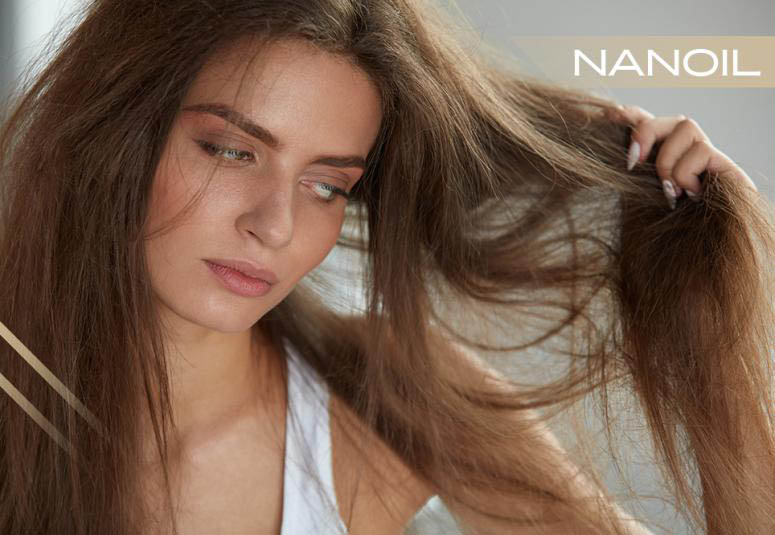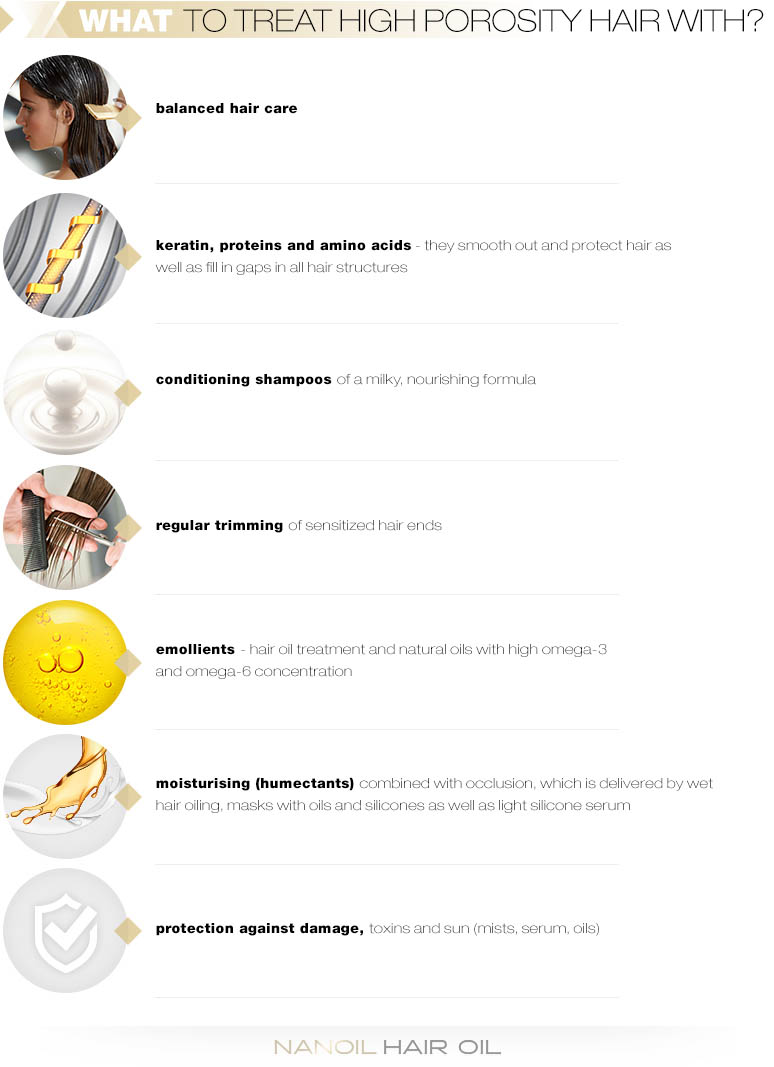- NANOIL Products
- Oils
- Face serums
- Hair masks
- Shampoos
- Hair conditioners
- Hair styling
- Hair Porosity Test
- Blog
- Contact

It absorbs water and nourishing substances like a sponge. Yet, this doesn't mean that it's an easy task to nourish it. This can be observed by looking at high porosity hair, which is a group of extremely damaged strands. High porosity hair is incredibly weak, brittle and dry, even stiff. It has the tendency to get frizzy and is easily affected by static. If you find your hair in a miserable condition - find out how to regenerate it and learn what things you should stay away from.
Hair's high porosity equals the last stadium of its deterioration. This type of hair is brittle, rough, with split ends, matte, dehydrated from ear-level downward, frequently very stiff and either faded due to the sun or because the pigments are fast to wash down. Moreover, high porosity hair is often highly sensitized. This means that it has increased tendency to deteriorate. Frequently, just a single use of a flat iron or hair dryer is all it takes to break the sulfur bridges located in inner hair structures. As a consequence, hair becomes incredibly dry (no ability to lock moisture in), rough, brittle and easy to break.
How does highly porous hair look like? Its damaged condition should be analyzed under a microscope to understand this better. Then, you will notice that the hair surface isn't smooth. The cuticles are lifted and widely-open, and therefore there is nothing that could protect the inner hair structures from toxins, temperature and aggressive substances delivered with ill-matching hair care products.

Of course, people aren't born with naturally highly porous hair. In most cases, it takes some time for hair to increase its porosity due to frequent exposition to damaging hairdressing procedures, e.g. bleaching or perm. Also, hair gets more porous as the consequence of improper care. Ill-matching cosmetics, long hours spent in air-conditioned rooms, sleeping with wet hair, wearing too tight updos and lack of any type of protection (occlusion) are the direct causes responsible for hair deterioration.
It's worth being aware of the fact that one of the factors contributing to increasing hair porosity are scalp ailments and systemic diseases (e.g. vitamin shortage), diseases and strong medication that weaken hair bulbs. Naturally, the tendency to dehydration might be inherited. This mainly affects curly and frizzy hair since its structure impedes distributing sebum along hair shaft evenly. As a result, hair is deprived of natural protective coat that prevents water loss. Therefore, improper hair care firstly destroys the superficial hair coat made of keratin cuticles and then negatively influences inner hair structures, which is cortex.
The main issue connected with high porosity hair isn't its miserable condition and the absolute necessity to rebuild the strands. What really makes high porosity hair care troublesome is its hypersensitivity to the external factors. To clarify, this means that it doesn't take much to weaken the strands condition, for example by frequent blow-drying. So what steps should be taken to deliver the right care to high porosity hair?
First and foremost, high porosity hair should be treated with gentle preparations, free from destructive detergents and substances that might worsen hair structure. 'Gentleness' is, so to say, the key word of the entire high porosity hair care.
The most important is to choose the hair care products that are gentle, deprived of heavy and irritating silicones and other comedogenic substances. Monohydroxy alcohols, which are the heaviest ones and easy to find in numerous hair care products, dehydrate the high porosity and fragile strands the fastest. For that reason, before getting a hair care product, scan the list of ingredients to eliminate the following substances: alcohol denat, benzyl alcohol, grain alcohol or isopropyl IPA.
Refrain from exposing the wisps to chemical treatments that disturb hair condition: bleaching and dyeing negatively influences the state of hair. Therefore, it's definitely better to spare synthetic dye or bleacher and go for natural herbal colorants, such as henna.
Instead of the above-mentioned hairdressing procedures, it's definitely better to carry out hair oil treatment. After all, many of natural oils aren't only able to fix the inner hair structures and reinforce hair bulbs but also intensify hair colour and boost its shine. Also, on daily basis try to use protective hair mists and sprays dedicated to high porosity hair - light and at the same time full of active substances that leave hair stronger and shielded against aggressive external factors. An oil-based hair mist should do the job too.
Taking care of high porosity hair is a never-ending battle not only with dryness and far-from-perfect looks but also it's entailed with making sure that hair loses neither hydration nor nourishment. Therefore, every time you carry out a beauty procedure, do your best to create so-called occlusion - a protective coat (best if made of emollients) that blocks nutrients from escaping from the inner hair structures.
High porosity hair gets along with all types of keratin treatments, no matter if professional ones carried out at a hairdresser's or home treatments and cosmetics with high keratin content. This protein is a natural constituent of hair and effectively fills in all gaps that happened to appear in the hair structures. In view of the fact that high porosity hair ends are severely damaged, bear in mind to shield these hair parts with either greasy and protective lanolin or the right hair end serum.
If possible, cut down on using a blow dryer and let your hair air dry. However, if blow-drying is required, always apply heat protection conditioners or lotions. Additionally, make sure that the air stream generated by this hair styling tool is low, best if you use cool air stream since it's able to close the hair cuticle, smooth hair and leave it shiny.
What's more, it's a good idea to braid wet hair or arrange it in a loose ponytail. Thanks to this you will prevent further damage and frizz. Lavish rich in nourishing substances hair masks and once in a week you can go for vinegar hair and scalp rinse - it'll restore scalp's pH and help your cuticle close naturally. Another highly advisable method to apply is the right way of hair washing: CSC or SCSC. In short, both methods depend on using double the portion of a conditioner during washing hair or double shampooing combined with intensive nourishing treatment carried out by using rich conditioners displaying deeply regenerating properties.
It also turns out to be beneficial to support the hair 'from inside,' which translates into preventing nutritional deficiency and reaching for high quality dietary supplements. High porosity hair needs a huge portion of proteins, vitamins (mainly A, E and B5), minerals (zinc, copper, silicon) and amino acids.
In order to combat excessive hair deterioration, get your hair trimmed regularly (at least 4-6 times a year).

Did you know that in terms of high porosity hair care the frequency of hair washing is crucial? Therefore, wash it only when the strands need it but don't do this too often because this might encourage further dehydration. Once in a while, you can turn to a gentle kids shampoo. It neither nourish nor cleanse hair so well as the regular shampoos do, however, it delivers delicate care that high porosity hair craves for.
It's also suggested paying attention to the way you wash the hair in. This procedure should depend on delicate scalp massaging, avoiding tugging or energetic hair rubbing. Also, you shouldn't spread a shampoo all over the hair. Instead, apply it to the scalp only while securing the hair ends with a conditioner. When it comes to rising the lather, use only lukewarm water that closes hair cuticles of high porosity hair. Finally, this hair type will be grateful if you wash it with milky, thick and emollient-rich shampoos filled with rebuilding substances.
Conditioner for high porosity hair should focus on rebuilding and improving hair. This type of hair is seriously damaged therefore even delicate silicone preparations serve their purpose - mainly in split ends care. Protein conditioners and humectants should be used in moderation since their excessive amount might weaken hair structure. Best if combined with oily emollients that know how to maintain hair protective coat. It must be also born in mind that too much of herbal washes or too frequent hair washing might do damage to hair structure especially if the product features too little emollients or delicate silicones.
Once or twice a week (if your hair's extremely damaged), find the time for the intensive-repair treatment. The Nanoil Hair Masks are made for this purpose - professional enhancers for the easy use at home. Highly-porous hair will surely love the Nanoil argan mask and the best-seller for damaged tresses: keratin-based mask
Oil for High Porosity Hair
High porosity hair requires being treated with oils definitely more often than other hair types. Therefore, carry out hair oil treatment even every 2-3 days until you notice improvement in its looks and condition. The finest blend of well-balanced oils serving damaged hair is Nanoil for High Porosity Hair.
Hair ends might be treated with single beautifying oils. The most important thing though is to use only unrefined and cold-pressed oils.
Vegetable oils with high unsaturated fatty acids content (omega-3 or omega-6) should be used to treat highly porous hair. This type of oils are made of molecules which size is big enough to adjust themselves to match the widely-open hair cuticles of high porosity hair.
It's also worth bearing in mind that saturated fatty acids with small molecules such as coconut oil or shea butter don't serve high porosity hair well. The reason for that is the fact that such oils aren't able to keep hair moisturized but instead they leave the strands frizzy.
In most cases such hair requires being exposed to an array of regenerating proteins and substances that don't only protect but also reconstruct hair as well as maintain hydration. The beneficial substances to treat high porosity hair with are:
Undoubtedly, during high porosity hair treatment, you have to continuously pay attention not to expose hair to the factors which might damage the already-weakened hair structure. Therefore, you must stay away from:
Leave your email address and we ll notify you when the product is back in stock.
Comments: #0